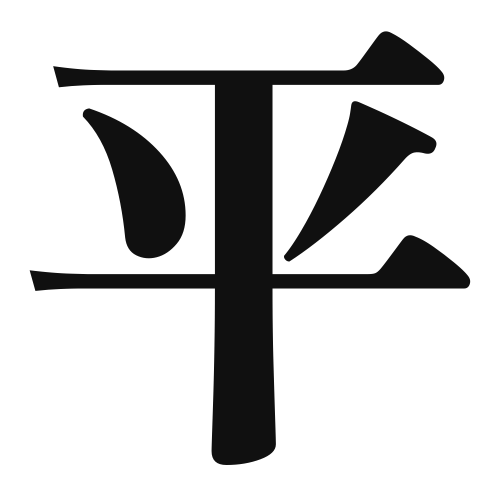1. Overview of Meaning
The kanji “平” (pronounced “hei” or “byou”) means “flat,” “even,” or “peace.” It conveys a sense of balance and tranquility, often associated with calmness and stability.
2. Formation and Radical
The kanji “平” is a phonetic-ideographic character (形声文字), which combines both meaning and sound. The character is composed of a horizontal line representing a flat surface, symbolizing evenness.
The radical for “平” is 水平 (sui), which relates to water and levelness, further emphasizing the concept of flatness and balance.
3. Examples of Usage
Common words and phrases that include “平” are:
- 平和 (heiwa) – peace
- 平面 (heimen) – plane (as in geometry)
- 平等 (byoudou) – equality
Example sentences in daily conversation:
- この道はとても平らです。 (This road is very flat.)
- 私たちは平和を望んでいます。 (We hope for peace.)
4. Synonyms and Antonyms
Similar kanji with related meanings include:
- 均 (kin) – meaning “even” or “uniform,” but often used in contexts of distribution or balance.
- 安 (an) – meaning “safe” or “calm,” which can also imply a sense of peace.
Antonyms include:
- 乱 (ran) – meaning “chaos” or “disorder.”
- 高 (kou) – meaning “high,” which contrasts with the flatness of “平.”
5. Cultural and Historical Background
The concept of “平” is deeply rooted in Japanese culture, often associated with the ideals of harmony and balance. In traditional Japanese gardens, for example, flat surfaces and even landscapes are designed to create a sense of peace.
Proverbs and idiomatic expressions that include “平” are:
- 平穏無事 (heion buji) – meaning “peaceful and uneventful,” often used to describe a calm life.
- 平和な心 (heiwa na kokoro) – meaning “a peaceful heart,” emphasizing the importance of inner tranquility.
